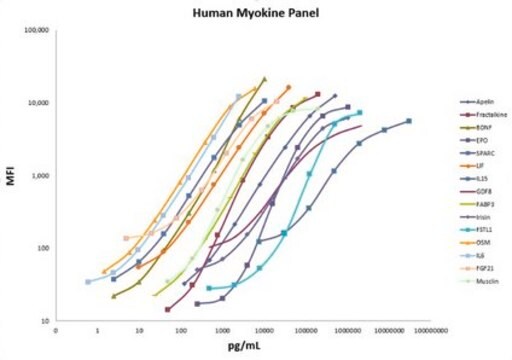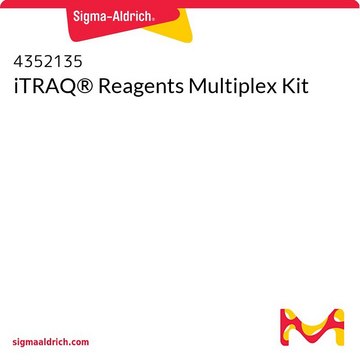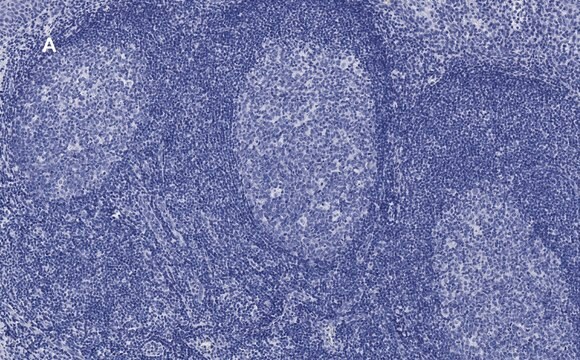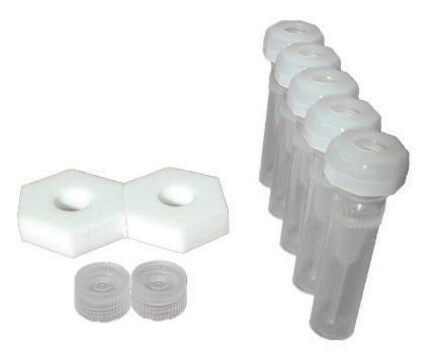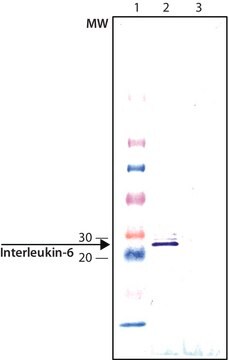MMYOMAG-74K
MILLIPLEX® Mouse Myokine Magnetic Bead Panel
Inflammation/Immunology Bead-Based Multiplex Assays using the Luminex technology enable the simultaneous analysis of multiple myokine and cytokine biomarkers in mouse serum and plasma samples.
About This Item
추천 제품
Quality Level
종 반응성
mouse
제조업체/상표
Milliplex®
assay range
accuracy: 3-40,000 pg/mL
(Osteocrin)
standard curve range: 0.6-9,000 pg/mL
(BDNF)
standard curve range: 128-2,000,000 pg/mL
(Osteonectin (SPARC))
standard curve range: 16-250,000 pg/mL
(Oncostatin M)
standard curve range: 22-350,000 pg/mL
(EPO)
standard curve range: 256-4,000,000 pg/mL
(Myostatin)
standard curve range: 26-400,000 pg/mL
(26Irisin)
standard curve range: 3-40,000 pg/mL
(LIF)
standard curve range: 3-40,000 pg/mL
(Osteocrin/Musclin (OSTN))
standard curve range: 48-750,000 pg/mL
(IL-15)
standard curve range: 5-75,000 pg/mL
(FGF21)
standard curve range: 9-140,000 pg/mL
(IL-6)
inter-assay cv: <15%
intra-assay cv: <10%
기술
multiplexing: suitable
검출 방법
fluorometric (Luminex xMAP)
배송 상태
ambient
일반 설명
MILLIPLEX® Mouse Myokine Panel is a 12-plex kit to be used for the simultaneous quantification of any or all of the following analytes in serum, plasma, and tissue culture samples: Brain-derived Neurotrophic Factor (BDNF), Erythropoeitin (EPO)*, Fibroblast Growth Factor 21 (FGF21), Follistatin-Like Protein 1 (FSTL-1), IL-6, IL-15, Irisin, Leukemia Inhibitory Factor (LIF), Myostatin (MSTN / GDF8), Oncostatin M (OSM), Osteocrin/Musclin (OSTN), Osteonectin (SPARC).
*Only available for cells culture samples.
This kit uses a 96-well format, contains a lyophilized standard cocktail, two internal assay quality controls and can measure up to 38 samples in duplicate.
The Luminex® xMAP® platform uses a magnetic bead immunoassay format for ideal speed and sensitivity to quantitate multiple analytes simultaneously, dramatically improving productivity while conserving valuable sample volume.
Panel Type: Metabolism
애플리케이션
- Analytes: Brain Derived Neurotrophic Factor (BDNF), Erythropoietin (EPO), Fibroblast Growth Factor 21 (FGF-21), Follistatin-like Protein 1 (FSTL1), IL-6, IL-15, Irisin, Leukemia Inhibitory Factor (LIF), Myostatin (MSTN/GDF8), Oncostatin M (OSM), Osteocrin (OSTN/Musclin), Osteonectin (SPARC)
- NOTES: BDNF - Substantial amounts of BDNF are stored in circulating platelets and subsequently released upon platelet activation. Therefore, platelet-poor plasma is critical to ensure accurate measurement of circulating levels of BDNF. OSM - While OSM is barely detectable in the serum/plasma of healthy subjects, a slight increase can be observed in certain disease states. Higher measurements in cell culture samples have also been reported. Erythropoeitin (EPO) is for tissue culture samples only and cannot be combined with other analytes in this panel when measuring serum or plasma.
- Recommended Sample Type: Mouse serum, plasma, or cell/tissue culture supernatants or lysates
- Recommended Sample Dilution: 25 μL per well of 1:2 diluted serum or plasma; cell/tissue culture samples may require dilution in an appropriate control medium.
- Assay Run Time: For greater sensitivity an overnight incubation is recommended, (16-18 hours) at 2-8°C. Alternatively, incubate for 2 hours at room temperature (20-25°C).
- Research Category: Metabolism
- Research Subcategory: Obesity, Metabolic Disorders, Inflammation
특징 및 장점
기타 정보
법적 정보
신호어
Danger
유해 및 위험 성명서
Hazard Classifications
Acute Tox. 4 Dermal - Acute Tox. 4 Inhalation - Acute Tox. 4 Oral - Aquatic Chronic 2 - Eye Dam. 1 - Skin Sens. 1 - STOT RE 2
표적 기관
Respiratory Tract
WGK
WGK 3
시험 성적서(COA)
제품의 로트/배치 번호를 입력하여 시험 성적서(COA)을 검색하십시오. 로트 및 배치 번호는 제품 라벨에 있는 ‘로트’ 또는 ‘배치’라는 용어 뒤에서 찾을 수 있습니다.
자사의 과학자팀은 생명 과학, 재료 과학, 화학 합성, 크로마토그래피, 분석 및 기타 많은 영역을 포함한 모든 과학 분야에 경험이 있습니다..
고객지원팀으로 연락바랍니다.
